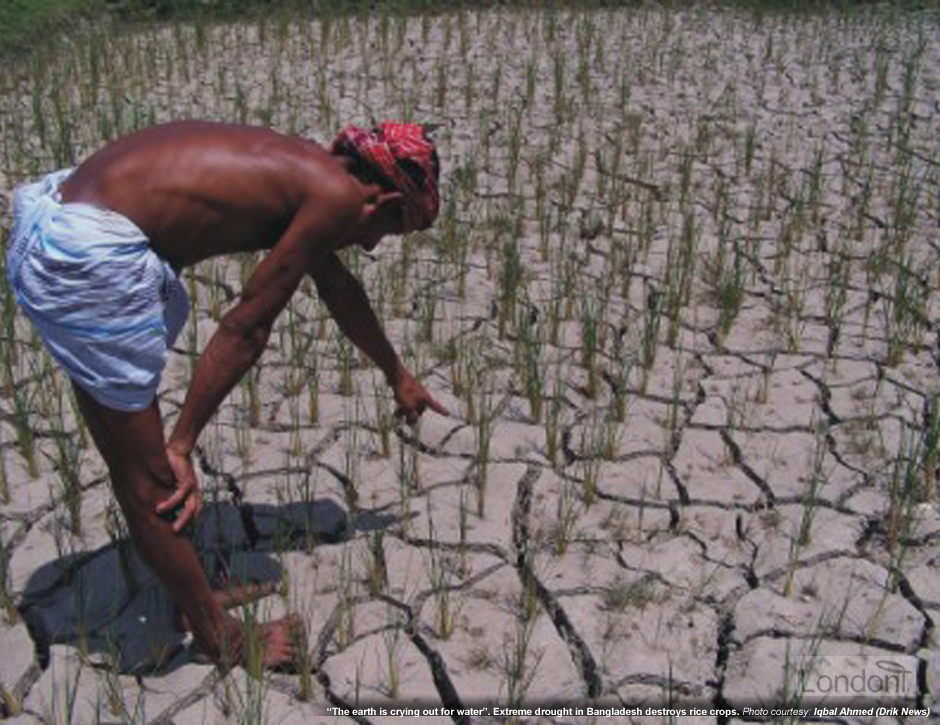
2-month long drought after two year of successive flooding force nationwide prayer for rain
Bangladesh was at the receiving end for two successive devastating floods of 1987 and 1988 which caused terrible havoc in the impoverished nation. This was quickly followed by a lengthy drought the following year.
Drought is the opposite hazard of flooding. They are periods of continuous dry weather resulting from serious hydrological imbalance or want of rain. Regions in which high pressure atmospheric systems are the norm are frequently described as arid.
Droughts are associated with the late arrival or the early recession of the monsoon rains and with intermittent dry spells coinciding with critical stages of the T. aman rice. Bangladesh experienced droughts in 1973, 1978, 1979, 1981, 1982, 1989, 1994, and 1995.
Bangladesh had drought during March and April 1989. And though the country had experienced 19 periods of drought, both major and minor, between 1967-2007 (i.e. 40 years), the drought of 1989 was the longest. The areas mostly hit by the drought were the south-western and north-western regions which generally has lower rainfall than the rest of the country.
The effects of this drought were felt especially in agricultural production where it threatened to destroy more than half the rice crop of this poor country. The country relies on irrigated rice for ensuring food security which is affected if droughts are longer. The 1989 drought dried up most of the rivers in Northwest Bangladesh with dust storms in several districts, including Naogaon, Nawabganj, Nilphamari and Thakurgaon. Drinking water supply, already at a low following the floods of the previous two years, had been hit even more further.
The drought affected 5 million people in Bangladesh, bringing normal flow of life to an almost standstill.
Zarina Khatoon sold her aluminum cooking pot to buy food for her four hungry children.
"The cooking pot was the last asset I could sell. My children were going without food for two days. They had nothing but water," Zarina said, wearing a ragged sari and sitting on the ground in front of her mud-and-straw house.
Her plight is common among the families of 65 million landless day laborers in this poverty-stricken nation of 110 million people. When there are no fields to tend, there is no money to earn.
The Jamalpur district, 90 miles north of Dhaka, was ravaged by last summer's monsoon-spawned floods. Now it suffers from drought. But so far the main problem is not availability of food, relief workers say. It's the shortage of work.
The sowing season is over. For landless day laborers, there will be no more work until the rice crop now in the ground is harvested in early June--if the paddies survive the drought.
Zarina Khatoon's husband, Mokbul Ahmad, left home to look for work. Two weeks later, he had not returned to Palashtala, 12 miles south of Jamalpur.
Shortly after he left, Zarina sold her cooking pot for 15 takas, about 46 cents. She promptly spent 31 cents on 2.2 pounds of flour, which saw her family through two meals.
The 25-year-old woman said her situation had improved slightly since she found work digging a pond for 15 takas a day.
"Still, I cannot buy rice for my family," she said. "Rice is out of my reach."
Rice is the staple of the Bangladeshi diet. Two weeks ago, low-quality rice sold for 28 cents a pound. The government pumped some reserve stocks into the area, and the price fell a little--to 25 cents a pound.
"It's not the question of availability of rice. The problem is the poor people have no money to buy food. They have no jobs," said Fakhrul Ahsan, a local worker for the privately run Bangladesh Rural Development Committee.
He said the committee is working with 56,000 people living in 47 villages in the Jamalpur region, doing post-flood rehabilitation work and trying to provide jobs such as building roads and making handicrafts.
"Almost 30% of the people we cover are living in extreme conditions," Ahsan said. "They take flour and boil it with water. They can't make bread from wheat as that fails to feed all the members of the family.
"This is a lean period for agriculture workers. There is no work in the fields until the next harvest comes. The poor, landless people eat on days they can work. On workless days they go without food," he added.
"We have no report of anyone dying for lack of food, but the situation is pretty bad," said Debabrata Das, another worker from the Bangladesh Rural Development Committee.
Abdul Hamid, who lives in Narayanpur near Palashtala, said he earned 15 takas a day working for wealthy farmers.
"The money I earn cannot buy rice for me and my family," the 35-year-old father of three said. "Rice has become a luxury item for us."
Bangladesh, where the per-capita annual income is $160, needs 18.5 million tons of rice and wheat a year to feed its people. In good years, it produces 17 million tons. It tries to import an additional 2 million tons to cover the shortfall and provide an emergency reserve.
Last year, the floods wiped out 2.5 million tons. The spring rice crop now in the ground was expected to produce about 5.6 million tons, but agriculture officials in Dhaka fear at least half will be lost to the drought.
President Ershad and 75,000 others
Such was the dire state of the nation President H. M. Ershad ordered nationwide prayers for rain and for an end to a drought that has been tormenting Bangladesh.
Hours later his and Bengali's prayers would be answered - but in a way that they'll live to regret.
In a grimly ironic twist, the tornado appeared just hours after then President Hussain Muhammad Ershad called upon the nation to pray for rain.
